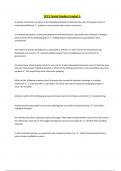Samenvatting
Uitgebreide Samenvatting Literatuur Ontwikkelingspsychologie
- Vak
- Instelling
- Boek
Dit is een uitgebreide samenvatting van alle literatuur die wordt getoetst tijdens het tentamen van het vak Ontwikkelingspsychologie. Dit bestaat uit het volledige boek: The development of Children (8th edition) en bijbehorende artikelen en hoofdstukken op Canvas. Dit vak is onderdeel van de bachel...
[Meer zien]













